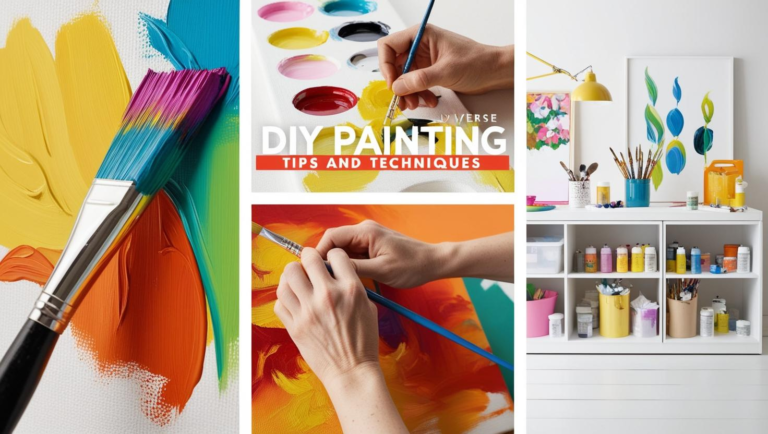Walls looking tired, dull, or outdated? Want to give your space a fresh, new vibe without hiring a professional? Great news—DIY wall painting is easier than you think! With the right tools, techniques, and a little patience, anyone can paint like a pro. In this guide, we’ll share simple and effective wall painting tips for beginners that will save you time, money, and mess.
Why DIY Wall Painting?
Whether you’re renting, selling, or just craving a change, painting your walls is the fastest and cheapest way to transform a room. A fresh coat of paint can make a small room feel bigger, add personality, and even increase your home’s value.
But before you dip that brush, let’s walk through everything you need to know.
Step 1: Get the Right Tools
The first mistake beginners make? Using the wrong or cheap tools. Here’s what you really need:
- Rollers (with extension pole)
- Angled brushes (for corners and edges)
- Painter’s tape (not masking tape!)
- Paint trays & liners
- Drop cloths or plastic sheeting
- Sandpaper or sanding sponge
- Putty knife + wall filler
- Cleaning cloth & mild detergent
💡 Pro Tip: Invest in a good quality roller and angled brush. It makes all the difference in the finish!
🏡 Step 2: Choose the Right Paint
Not all paints are created equal. Choosing the right type and finish matters.
Paint Finishes:
- Matte/Flat: Great for ceilings and low-traffic areas. Hides imperfections.
- Eggshell/Satin: Perfect for living rooms and bedrooms. Slightly washable.
- Semi-gloss/Gloss: Best for kitchens, bathrooms, or kids’ rooms. Easy to clean.
Types of Paint:
- Water-based (latex): Quick-drying and easy to clean. Best for indoor walls.
- Oil-based: More durable, but smells stronger and harder to clean.
📝 Note: Always test a small patch on your wall to check color under natural and artificial light.
🧽 Step 3: Prep Like a Pro
Prep work is 80% of the job. Don’t skip it if you want professional-looking results.
- Move Furniture: Or push to the center and cover with a drop cloth.
- Clean the Walls: Use mild soap and water to remove dust, grease, or marks.
- Fill Holes & Cracks: Use wall putty and a putty knife. Let dry, then sand smooth.
- Sand Glossy Surfaces: Light sanding helps paint stick better.
- Tape Edges & Switches: Use painter’s tape around trim, baseboards, sockets, and windows.
🧼 Bonus Tip: Use a damp cloth to wipe down sanded areas before painting.
🎨 Step 4: Painting the Right Way
Here’s how to get those smooth, clean walls without streaks or blotches.
1. Cut In First
Use an angled brush to paint a 2–3 inch border around the edges, corners, and trim. This is called “cutting in.”
2. Use the Roller
- Dip roller in tray, roll off excess
- Apply in a “W” or “M” shape to spread paint evenly
- Fill in gaps without lifting the roller too much
3. Don’t Overwork It
Once paint starts drying, avoid re-rolling the same area—it can cause streaks.
4. Apply Two Thin Coats
One thick coat can drip or dry unevenly. Two thin coats always look better. Wait at least 2–4 hours between coats (read the paint can for exact time).
🔄 Pro Tip: Keep windows open and fans on for better ventilation and faster drying.
🧼 Step 5: Finishing Up
After painting, it’s time to clean up smartly.
- Peel Off Tape Carefully: Do it slowly while the paint is slightly wet for sharp edges.
- Wash Brushes & Rollers: Use warm soapy water (for water-based paints).
- Store Extra Paint: Label the can with the room and color. Keep for touch-ups.
🚫 Common DIY Painting Mistakes to Avoid
- Skipping the primer: Especially important if you’re covering dark colors or patchy walls.
- Using cheap brushes or rollers: They leave marks and shed bristles.
- Painting over dirty or damp surfaces: Leads to peeling later.
- Rushing the drying time: Causes smudges and uneven texture.
- Ignoring lighting conditions: Always check how the paint looks under different lights.
🧠 Bonus DIY Wall Painting Hacks
- Wrap rollers in plastic wrap or aluminum foil between coats to prevent drying.
- Use a rubber band across the paint can to wipe excess off your brush.
- Add vanilla extract or essential oil drops to reduce paint smell.
- Use a hairdryer to speed up drying in small patches (use carefully!).
🧾 Final Thoughts: You Can Paint Like a Pro!
DIY wall painting doesn’t have to be messy, frustrating, or complicated. With the right prep, tools, and a bit of patience, you can achieve smooth, beautiful walls that look like they were done by a professional—at a fraction of the cost.
Don’t forget to take before-and-after photos and celebrate your transformation!
